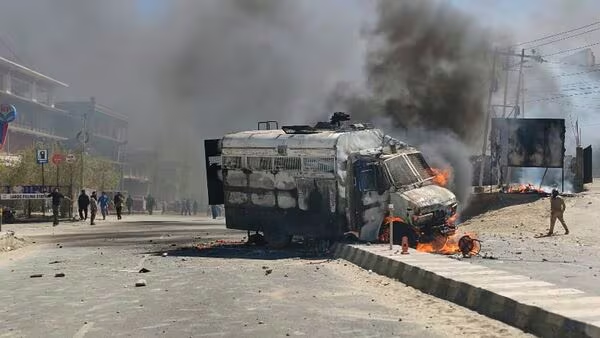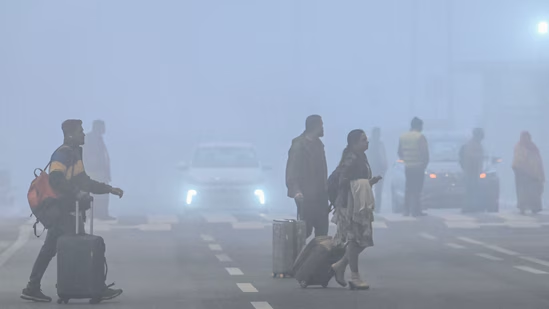
On September 24, 2025, the quiet streets of Leh erupted in flames. What began as a shutdown call over Ladakh’s autonomy spiralled into the bloodiest protests the region has seen in years: a BJP office was set ablaze, a paramilitary van torched, stones were hurled at police, and tear gas filled the air. By evening, at least four protestors were dead, more than 70 civilians were injured, and 30+ security personnel were hurt. Over 100 protestors were arrested, with families claiming some are still missing. The Union Territory administration imposed curfew under Section 163 of the BNS, turning Leh into a garrison town.
An estimated 5,000–10,000 protestors—nearly one-third of Leh’s population—had taken to the streets. Many were young students, monks, and women. This was no ordinary disturbance. It was the boiling point of six years of frustration across both Leh (Buddhist-majority) and Kargil (Muslim-majority).
From Hope to Betrayal: How Ladakh Reached This Point
Until 2019, Ladakh was part of Jammu & Kashmir (J&K). Despite covering 60% of J&K’s land area, it received only 2% of the state budget, fueling resentment. When Article 370 was revoked and Ladakh became a Union Territory (UT), many celebrated freedom from Srinagar’s neglect. But the reality was bitter—Ladakh became a UT without a legislature, ruled by a Lieutenant Governor appointed by Delhi.
Even the Ladakh Autonomous Hill Development Councils (LAHDCs) in Leh and Kargil were sidelined, reduced to powerless bodies. Promises of constitutional safeguards never materialised.
From 2020 to 2024, protests steadily grew. Activist Sonam Wangchuk staged hunger strikes highlighting Ladakh’s fragile environment. A High-Powered Committee formed in 2023 met several times, but talks stalled without progress.
In September 2025, Wangchuk and 14 others, including seven ex-Army soldiers, began a 35-day hunger strike. When two collapsed and were hospitalised, anger spilt over. On September 24, the shutdown call brought thousands to Leh’s streets—and ended in tragedy.
Protest Conditions: A Region Under Siege
- Curfew in Leh: Gatherings banned, security checkpoints everywhere.
- Shops & Markets Closed: Traders said losses touched ₹50 crore in a single day.
- Tourism Collapse: The cancellation of the Ladakh Festival 2025 alone meant losses of ₹10 crore. Winter bookings dropped 30%.
- Hospitals Overwhelmed: Leh’s SNM Hospital had just 50 beds but treated 70+ injured; oxygen shortages at 11,500 feet worsened outcomes.
- Families Grieving: Four young men were killed, aged between 19 and 28. One was a shop worker, another a college student.
- Internet Disruptions: Residents reported slowdowns and blackouts, accusing Delhi of silencing them.
- Kargil’s Response: The Kargil Democratic Alliance announced its own shutdown. Shia leaders declared, “This is not just Leh’s fight. It is Ladakh’s fight.”
The Core Demands
Protestors demand four key protections:
- Statehood – their own elected assembly, ending rule by Delhi-appointed officials.
- Sixth Schedule Status – constitutional safeguards (like in Northeast India) for Ladakh’s 97% tribal population, giving them control over land, forests, and jobs.
- Jobs & Land Security – 100% government jobs reserved for locals; strict rules preventing outsiders from buying land.
- Better Representation – separate Lok Sabha seats for Leh and Kargil instead of sharing just one.
As LAB’s youth wing declared:
“We are not anti-development. We are anti-exploitation.”
Voices from the Ground
- Youth: With 70% unemployment and only one underfunded university, frustration fuels the protests. “We study hard, but jobs go to outsiders,” said Tsering, a student.
- Women: Over 500 women marched with the Ladakh Women’s Alliance, holding placards reading “Save Our Land, Save Our Future.” “If outsiders buy our farms, what will our children inherit?” asked Dolma, a mother of three.
- Elders & Monks: Many urged non-violence but stressed survival. “Our fragile mountains cannot survive Delhi’s blueprint. Sixth Schedule is our lifeline,” said a monk in Thiksey.
- Kargil Clerics: Shia leaders warned Delhi against ignoring Ladakh again. “Every drop of blood spilt strengthens our unity,” one cleric declared.
- Wangchuk: After ending his fast due to ill health, he called the uprising a “Gen Z revolution”: “Peaceful paths were blocked. The youth said they’ve been ignored for too long.”
Delhi’s Reaction
The Centre quickly pushed back, blaming protest leaders:
- The Union Home Ministry said it has been “actively engaged with Apex Body Leh and Kargil Democratic Alliance” and held “a series of meetings, both formal and informal.”
- It accused Wangchuk of making “provocative statements” referencing the Arab Spring and Gen Z uprisings in Nepal, claiming these incited the mob.
- Officials described the violence as “planned, not spontaneous.”
- The Lieutenant Governor expressed condolences but said “vested interests” conspired to sabotage the scheduled talks on October 6.
- At the same time, the Home Ministry insisted, “The Government stands committed to the aspirations of the people of Ladakh by providing adequate constitutional safeguards.”
Opposition voices pushed back. Omar Abdullah argued Ladakh was being punished for the BJP’s electoral setbacks: “Because the BJP lost, Ladakh is being denied its rights.”
Wider Impact
- Economy: Traders, farmers, and hoteliers all report heavy losses. Taxi drivers said they haven’t had rides in days.
- Religion & Unity: Buddhist monks and Shia clerics rarely unite, but here they stand together, giving the movement rare strength.
- Climate Concerns: Glaciers are melting, water sources are shrinking—locals fear big projects will make survival harder.
- Media Divide: National TV labelled the unrest “anti-national,” while local papers called it “a fight for dignity.” On X, #LadakhProtests trended, splitting the country’s opinion.
- Comparisons: Like the farmers’ protests of 2020–21, Ladakhis rely on shutdowns and sit-ins. But unlike farmers, their numbers are small—their leverage is Ladakh’s strategic geography.
What Happens Next?
Talks are scheduled for October 6, 2025, but butscepticism runs deep.
- If Delhi offers partial safeguards like job quotas but not statehood, protests may continue.
- If demands are ignored, unrest could spread to Kargil, risking wider instability.
- If Delhi concedes Sixth Schedule status, it could calm tensions but set a precedent for other regions.
- If nothing changes for years, Ladakh may see migration, deepening alienation, and growing space for extremist voices.
Conclusion
The Leh protests of 2025 are not just about Ladakh—they test the balance between local democracy and central control.
For Ladakhis, it is a fight for land, jobs, and identity in a fragile mountain desert.
For Delhi, it is about holding a strategic frontier against China and Pakistan.
The flames in Leh are a warning. If Delhi responds only with blame and curfews, Ladakh’s cold desert could become the furnace of India’s next federal crisis. If it listens and negotiates sincerely, this could yet become a model of peaceful federalism.
FOR MORE BLOGS – beyondthepunchlines.com

 Add to favorites
Add to favorites








